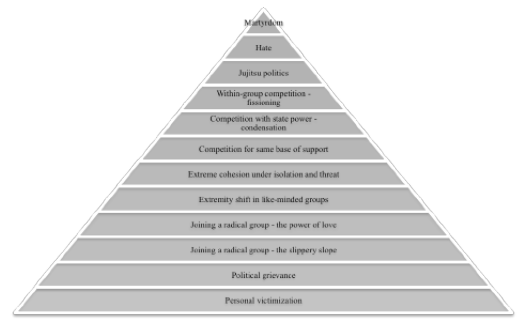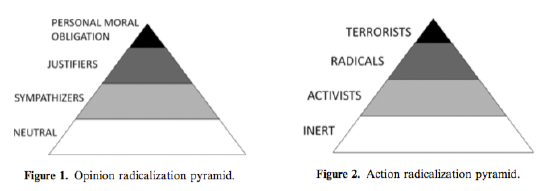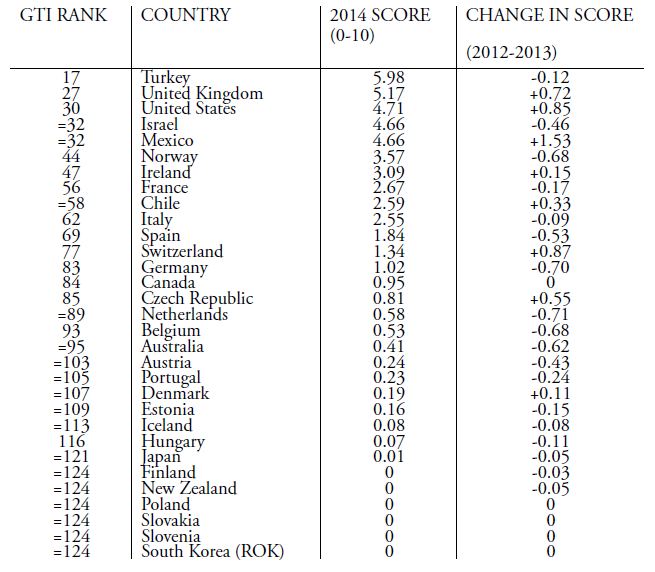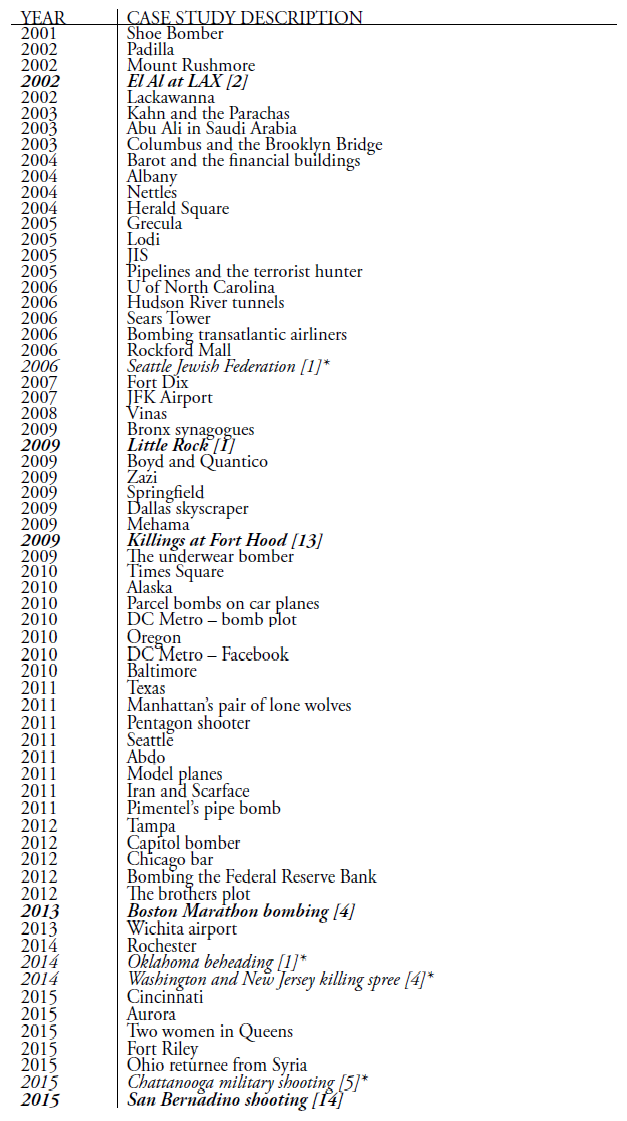From Cornell International Affairs Review VOL. 9 NO. 2Hearts and Minds: A Comparison of Counter-Radicalization Strategies in Britain and the United States
IN THIS ARTICLE
KEYWORDS
AbstractBataclan. San Bernadino. One need not read any further to understand how radicalization is crucial to counterterrorism and national security. Some states have implemented counter-radicalization strategies to cull terrorism at its root. These tactics fall within two broad groups: the North American method, which emphasizes behavioral radicalization, and the European method, which stresses cognitive radicalization. This paper compares the two methods by examining counter-radicalization strategies in the United States and in the United Kingdom. Case studies explain the social ramifications and the effectiveness of the US' Countering Violent Extremism policy and the UK's Prevent strategy, and the roles they play in abolishing or inadvertently incentivizing social divisions that lead to radicalization and terrorism. While the US strategy emphasizes the role of law enforcement, the UK strategy focuses on the role of community in preventing terrorism, including those of universities and healthcare providers. This difference is crucial in how Muslim communities view their place in the broader context of society, which makes up a fundamental precept of political alienation. Consequentially, this paper brings radicalization studies out of the ivory tower and into its broader sociopolitical context and effects. IntroductionOn 11 November 2015, Antoine Leiris lost his wife in the Bataclan attacks. In the following days, he wrote a Facebook post that went viral: I will not grant you the gift of my hatred. You're asking for it, but responding to hatred with anger is falling victim to the same ignorance that has made you what you are. You want me to be scared, to view my countrymen with mistrust, to sacrifice my liberty for my security. You lost.2 Responses to the post on The Independent's website were divided. The first commenter acknowledged Leiris' bravery and wished that he or she could be so brave in similar circumstances. In a sharp contrast, the second comment read: "Exactly the sort of appeasing, apologist response which terrorist would crave. In part, they despise the West because we are so weak."3 The questions on how to best combat terror in Western states remain unanswered. More importantly, they remain central to national security discussions following the Brussels airport bombing on 22 March 2016. Nevertheless, this paper seeks to comparatively analyze two methods of radicalization as a way of furthering our understanding of what good counter-radicalization programs can achieve, and how such programs can inadvertently create terrorists. HypothesisPeople are mortal, but ideas are immortal. The European method of stressing cognitive radicalization in preventing jihadi extremism is founded in the belief that this form of radicalism is akin to the rise of fascism in the 1930s.4 This is not the case. Hitler's rise was founded on the basis of racial supremacy, while radicalization in Western states comes from a place of political marginalization, as evidenced by the case studies in this paper. Furthermore, the idea of labeling certain types of speech as "dangerous" establishes a precedent for the erosion of free speech and could lead to more backlash than actual cognitive cohesion. As such, the North American method5 of preventing behavioral radicalization is more effective. By not publicly labeling a social group as "likely to become terrorists" and delineating the threshold for government intervention at terrorist acts rather than radical statements, the American government is able to better maintain social cohesion in a way that the UK's method seeks to achieve, but fails in reality. A Tale of Two MethodsThe director of the International Center for the Study of Radicalisation (ICSR), Peter R. Neumann, details a fragmentation in radicalization studies in a 2013 article. Radicalization has come to mean multiple things. One definition of radicalization emphasizes cognitive radicalization, in which an individual has extremist beliefs but might not act upon them due to social and legal norms. They are the individuals at the zenith of McCauley and Moskalenko's opinion radicalization pyramid, as shown in Figure 1.2. The other definition is behavioral radicalization, in which an individual expresses extremist beliefs and will do anything to see those beliefs imposed onto society or brought into reality.6 These are the individuals atop both the opinion radicalization and action radicalization pyramids. To summarize, all behavioral extremists are cognitive extremists, but not all cognitive extremists are behavioral extremists. This academic debate has influenced policymakers, as the US and UK have pursued counter-radicalization strategies based on different definitions of radicalization. In accordance with the First Amendment, which protects free speech, the United States' counter-radicalization strategy is targeted at behavioral radicalization. It has the effect of clearly demarcating a line between what is legal versus what is illegal. Neumann describes the American society as having a deep belief in the freedom of speech and an abiding faith in the strength of its republican institutions. The result is that divisive and anti-democratic speech, such as that used by the Westboro Baptist Church, is allowed despite being frowned upon by the vast majority of American society. Since it clearly demarcates what is legal and not, this strategy relies on law enforcement to prevent what is already illegal from happening and prevents citizens from acting upon their implicit biases. This is important to Americans, as the country is commonly referred to as a melting pot of cultures and ethnicities. According to Neumann: "[North Americans], in fact, do not like using the term ‘counter-radicalization', which they believe smacks of ‘thought police', preferring to talk of ‘countering violent extremism'."7 In contrast, the European approach stresses the importance of preventing cognitive radicalization. This belief stems from the long shadow Hitler's Germany left over the continent. It posits that extremist beliefs, if widely held, can manipulate and transform democracies into authoritarian regimes. Hence, terrorism is not illegal action in the pursuit of political goals but rather the result of failing to prevent cognitive radicalization.8 He invokes Karl Popper: "If we extend unlimited tolerance even to those who are intolerant, if we are not prepared to defend a tolerant society against the onslaught of the intolerant, then the tolerant will be destroyed, and tolerance with them."9 Even though it muddles the law by drawing increasing shades of illegality on certain types of thought, counter-radicalization is about promoting democracy and social cohesion.10 In other words, the European method is about promoting the greatest amount of good for the greatest number of people. Unfortunately, combating fascism and combating jihadism are not alike. Hitler detailed how he would make Germany a great empire again in the form of the Third Reich. He seized political control by taking advantage of severe economic and political malaise and turbulence caused by the ravages of World War I. On the other hand, jihadists claim that the global Muslim community is under attack by intolerant Western societies that would happily burn the Qu'ran. The methods to counteract the two cannot be the same, because their goals are not the same. Consequently, to implement a policy that would allow for implicit intolerance to turn from thought into action is exactly what the terrorists would use as fodder for their propaganda. The rest of this paper will detail what it takes to combat the jihadist narrative, and what it really means to effectively counter radicalization. The Theory of RadicalismTo best understand how counter-radicalization works, it is important to understand how people reach a state where they are classified as violent fundamentalists. The vast majority of Muslims will never become fundamentalists, and even fewer of them are socialized in a violent manner that leads to terrorism. Clark McCauley and Sophia Moskalenko describe radicalization as a pyramid with three overarching stages. The three main stages of radicalization are: individual, group, and mass. The base of the pyramid represents the broad social movement, whereas the apex of the pyramid represents the few that are terrorists.11 At the base of the pyramid, the broad social movement encompasses all sorts of people who vaguely align with the cause the terrorists are supporting. In the case of jihadism, it can mean anyone who does not believe that the Iraq or Afghanistan wars were warranted and that Muslims are demonized in the media. Such is the individualistic and petty nature of personal grievance. When personal grievances mobilize people because the issue affects a large swath of people, it turns into political grievance. From there, individuals enter radical groups, and become pressured to think alike and conform for the sake of the group and the cause they are representing. The group competes with other radical groups to be the main or the sole group representing the cause; for example, al-Qaeda and Daesh competed throughout 2014 to see which group would become the face of the jihadi movement. The large movement also experiences fissioning, as members compete for authenticity and recognition as "true believers."12 To illustrate, Daesh was once a faction of al-Qaeda before getting expelled by Ayman al-Zawahiri, the head of al-Qaeda, for being too radical in their beliefs.13 At the apex of the pyramid, the group turns into a mass that uses fear to achieve its political goals. Dehumanization of the enemy occurs; with Daesh, they label anyone who does not believe in the jihadist ideology as a kafir, or infidel.14 The radicalized viewpoint, no matter what ideology or time period, tends to follow the same trend: "We are a special or chosen group (superiority) who have been unfairly treated and betrayed (injustice), no one cares about us or will help us (distrust), and the situation is dire – our group and our cause are in danger of extinction (vulnerability)."15 This explains how people become part of terrorist groups, but does not fully explain homegrown terrorism. Since 9/11, there has not been an attack on US or UK soil that has been orchestrated by a group like al-Qaeda. Homegrown terrorists have all been lone wolf terrorists, or radicals inspired by the actions of groups like al-Qaeda and Daesh. However, they have not been in contact with terrorists in the Middle East, which makes it more difficult for law enforcement to detect their plans. Equally perplexing is how such people became radicalized without direct contact with the terrorist groups they glorified. According to McCauley and Moskalenko, though, the radicalization occurs in a bifurcated process: opinion radicalization and action radicalization. Opinion radicalization is the metric by which people either are neutral or agree that the jihadists are justified. For example, a sympathizer may agree that a war on terror equals a war on Islam, but a justifier believes that jihadists are right to detonate improvised explosive devices (IEDs) at American troops in Iraq.17 At the very apex of the pyramid, a person holds the same Weltanschauung as a terrorist in an organized group. Having radical opinions does not mean that all radicals are violent, though. Psychological studies show a massive variation exists in how beliefs influence actions. The gap between beliefs and actions is small in voting choices, but large when strong social and legal norms run counter to the person's attitude. That is why it is difficult to determine who is a peaceful radical and who is a terrorist, because some radicals are deterred from acting upon their violent words by sheer fact that murder and mayhem are illegal. As such, they may be at the apex of the opinion radicalization pyramid, but only rank amid the bottom two tiers of the action radicalization pyramid. Meanwhile, some individuals with criminal histories do not see the law as a deterrent, and pursue terrorism for the thrill, status, and the ability to act out their personal grievances.19 Conversely, they may rank lowly on the opinion radicalization pyramid, but represent the top of the action radicalization pyramid. McCauley and Moskalenko's research shows that three factors are importwith perceived hypocrisy, or the internal need for consistency between words and actions, 2) strong identification with perceived victims, and 3) opportunity and means to carry out violence. While terrorists in a group tend to have a normal psychological profile and are pushed towards radicalism by groupthink, lone wolf terrorists have greater instances of psychiatric problems. In that sense, lone wolves are akin to school shooters and assassins. The latter two categories of people also carry out attacks based on personal grievances, albeit generally not linked to any "higher cause." Among school shooters and assassins, four characteristics are common: grievance, depression, unfreezing (situational crisis of personal disconnection and maladjustment), and prior experience with weapons. In many cases, lone wolves display one or more of these characteristics. Nidal Hasan, the Fort Hood terrorist, for example, experienced all four characteristics before carrying out his attack. He was unsettled and depressed by the death of his parents, viewed the Iraq and Afghanistan wars as a war against Islam, and had prior experience with weapons due to his career in the US Army.20 Extant literature on comparative counter-radicalizationThe vast majority of counter-radicalization literature bears titles like: "Online De-Radicalization? Countering Violent Extremist Narratives: Message, Messenger and Media Strategy,"21 or "Terrorist Drop-outs: One Way of Promoting a Counter-Narrative."22 They are solution-oriented, designed to provide a solution to the homegrown terrorism problem. They center on a few key policy recommendations:
Because counter-radicalization scholars are mainly focused on how to counter online terrorism and combat jihadist propaganda, comparative studies of extant counter-radicalization studies have been given short shrift. Noted counterradicalization scholar Lorenzo Vidino briefly discusses the choice between targeting cognitive radicalization versus behavioral radicalization in a single paragraph in his U.S. Institute of Peace report: "Policymakers need to decide whether to target only violent radicalization or, more broadly, cognitive radicalism. … Such intervention would take very different forms, depending on whether it sought to tackle cognitive or behavioral radicalism."26 While Vidino loosely suggests considering a strategy that includes cognitive radicalization as its target, it is not the aim of the study. This gap is evidenced in other papers, where the comparison between cognitive and behavioral radicalization as well as the programs resulting from each strategy is overlooked. In comparing the US's CVE tactics to the UK's Prevent strategy, this paper seeks to rectify this gap in the literature. US' Countering Violent Extremism strategyThe United States' Countering Violent Extremism (CVE) strategy is an umbrella term for broad group of strategies and programs designed to supplement the US's robust counterterrorism program. Programs include the "If You See Something, Say Something" campaign and the Building Communities of Trust Initiative, both developed by the Nationwide Suspicious Activity Reporting (SAR) Initiative. The Nationwide SAR Initiative (NSI) is under the dual jurisdiction of the Department of Homeland Security and the Department of Justice.27 The White House has also published a Strategic Implementation Plan (SIP) to coordinate this strategy among the plethora of federal, state, and local agencies. The White House describes its method as "community-based" and centered around different forms of violent extremism, including religious, rightwing, and anti-Semitic terrorism. The strategy is focused on establishing connections between law enforcement and Muslim communities. The SIP stresses engagement as a main objective, in order to counter the "us vs. them" narrative that Daesh and other radical groups perpetuate. It also explicitly notes the dangers that misinformation can present, and the concern that it may cause antiMuslim sentiment and terror attacks.28 However, the centerpiece of the CVE strategy is the lack of government intervention in personal affairs: Countering the ideologies and narratives that legitimize violence is central to our effort, but it also is the most challenging area of work, requiring careful consideration of a number of legal issues, especially those related to the First Amendment. In many instances, it will be more effective to empower communities to develop credible alternatives that challenge violent extremist narratives rather than having the Federal Government attempt to do so.29 In doing so, the SIP acknowledges the role of civil society in rejecting radicalism itself and the distrust that a government-sponsored message might foster. It concludes by noting that opportunity and meritocracy comprise the core of the American dream, and that those values are central to combating violent extremism. UK's Prevent strategyIn contrast to the brevity of the American strategy documents, which number no more than thirty pages combined, the single Prevent strategy document is over a hundred pages. Its contents describe the many ways the British government and its people will challenge terrorism. Its themes include the necessity for all British citizens to combat terrorism and to protect British values, maintaining freedom of speech and social cohesion, and the use of social channels to achieve this. These themes resonate in the three objectives of the Prevent strategy: challenging the ideology that supports terrorism and those who promote it, protecting vulnerable people, and supporting sectors and institutions where there are risks of radicalization.30 In sharp contrast to the CVE strategy, the Prevent strategy is designed to identify vulnerable individuals during their road to radicalization during either the individual (bottom) stages or the group (intermediate) stages of McCauley and Moskalenko's pyramid of radicalization. By having Prevent-trained school officials and healthcare providers reporting vulnerable officials to authorities, the strategy seeks to "pre-empt and not facilitate law enforcement activity," as labeling Prevent as an avenue for police to arrest people can "create suspicion of Prevent and a reluctance to engage with it."31 It is not designed to punish vulnerable citizens but rather to teach them the error of their ways. The Prevent strategy document explicitly mentions that terrorists are overwhelmingly under the age of thirty. A substantial number received post-secondary education. Hence, the cornerstone of Prevent falls on secondary and post-secondary school officials, because they are most likely to recognize when a peer is being radicalized. Schoolchildren are not encouraged under the belief that some too immature to understand and recognize the patterns of behavior involved in radicalization. The second pillar of prevention is with the healthcare system. Nearly every British citizen encounters the National Health Service (NHS) at some point in their lives; hence, healthcare providers are likely to recognize the "signs that someone is vulnerable to radicalisation, interpret those signs correctly and access the relevant support."32Continued on Next Page » Suggested Reading from Inquiries Journal
Inquiries Journal provides undergraduate and graduate students around the world a platform for the wide dissemination of academic work over a range of core disciplines. Representing the work of students from hundreds of institutions around the globe, Inquiries Journal's large database of academic articles is completely free. Learn more | Blog | Submit Latest in Political Science |























